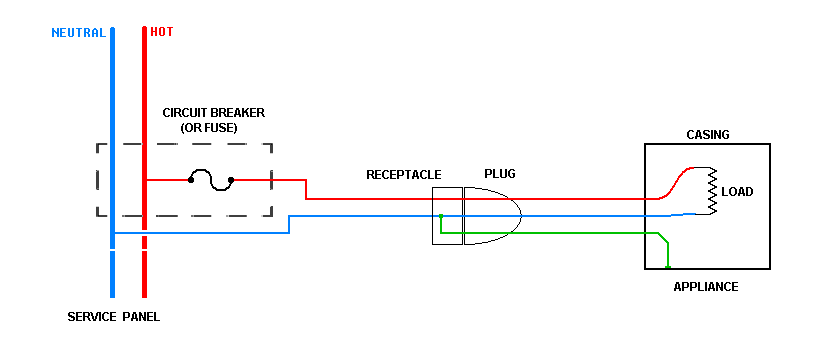This can be caused by a bootleg ground together with a poor neutral connection at the service panel.
In building wiring, a bootleg ground is an electrical ground that is wired from the neutral side of a receptacle or light fixture in an older 2-wire home. This essentially connects the neutral side of the receptacle to the casing of an appliance or lamp. It can be a hazard because the neutral wire is a current-carrying conductor, which means the casing can become energized.
You have probably encountered the combination of bootleg grounds on some of your receptacles, and a failing neutral path somewhere between the receptacle and the neutral connection from the power utility.
Here are some diagrams that you can show to your local electrician:
Home wiring with correct fault grounding:
 This is the correct way to protect against the appliance case accidentally becoming electrified. If the hot wire (red) insulation fails inside the appliance, the casing will become hot, and almost instantly the circuit breaker will open.
This is the correct way to protect against the appliance case accidentally becoming electrified. If the hot wire (red) insulation fails inside the appliance, the casing will become hot, and almost instantly the circuit breaker will open.
Home wiring without fault grounding:
 The earliest home wiring in my country (USA) didn't have fault grounding, and the appliances of that era didn't have little green ground wires.
The earliest home wiring in my country (USA) didn't have fault grounding, and the appliances of that era didn't have little green ground wires.
Using a modern appliance in such an old house involves living without fault ground protection. As you can see from the diagram, there is obviously no place for the appliance's fault ground connection to go. Most users either use an adapter incorrectly, or break the round ground pin off the plug.
Bootleg ground -- what you evidently have:
 Unscrupulous home sellers and misguided handymen may for various reasons connect the fault ground to the neutral wire inside the receptacle.
Unscrupulous home sellers and misguided handymen may for various reasons connect the fault ground to the neutral wire inside the receptacle.
Sellers do this because they want to give the appearance of fault ground wiring in the house. An untrained repairman may do this because he thinks it is safer than leaving the ground disconnected.
Dangerous failure in a bootlegged circuit:
 In every country, as far as I know, the neutral service connection is held near earth potential by the utility company's wiring, so connecting an appliance's fault ground to the neutral wire does provide some protection against an insulation failure inside the appliance.
In every country, as far as I know, the neutral service connection is held near earth potential by the utility company's wiring, so connecting an appliance's fault ground to the neutral wire does provide some protection against an insulation failure inside the appliance.
BUT it introduces a more dangerous and much more common failure mode, the broken neutral. You are much more likely to encounter a corroded or broken neutral wire in an old house than you are to encounter failed insulation in a new appliance. The neutrals are usually clamped to a copper bar in the service panel, and these connections will become corroded over time.
When the neutral path is broken anywhere between the bootleg ground and the service panel, everything that is "grounded" becomes live. You can trace the path in the diagram, from the circuit breaker, thru the hot wire (red), thru the appliance load, down the neutral wire (blue), thru the bootleg connection, and thru the ground wire (green) back to the appliance casing. Because of the high resistance of the failing neutral (probably at the service panel), the appliance casing will be energized and current will flow to nearby earth through any accidental path provided, such as you.
Now, it's true that any current that flows through a person touching an appliance casing must also flow through the appliance loads, which is probably the only reason you are still alive. Note that the more appliances you have running the greater the shock you will get.
Connecting a ground wire to the plumbing is a stopgap that may prevent you being electrocuted by touching an appliance, but it introduces a new problem: you can now be electrocuted by touching your plumbing.
You are not going to be able to safely fix this yourself. You must call a licensed professional electrician. Even if you applied some repairs and got rid of the symptoms, without training and experience you might not find all the problems, and would be subjected to dangers later on.





